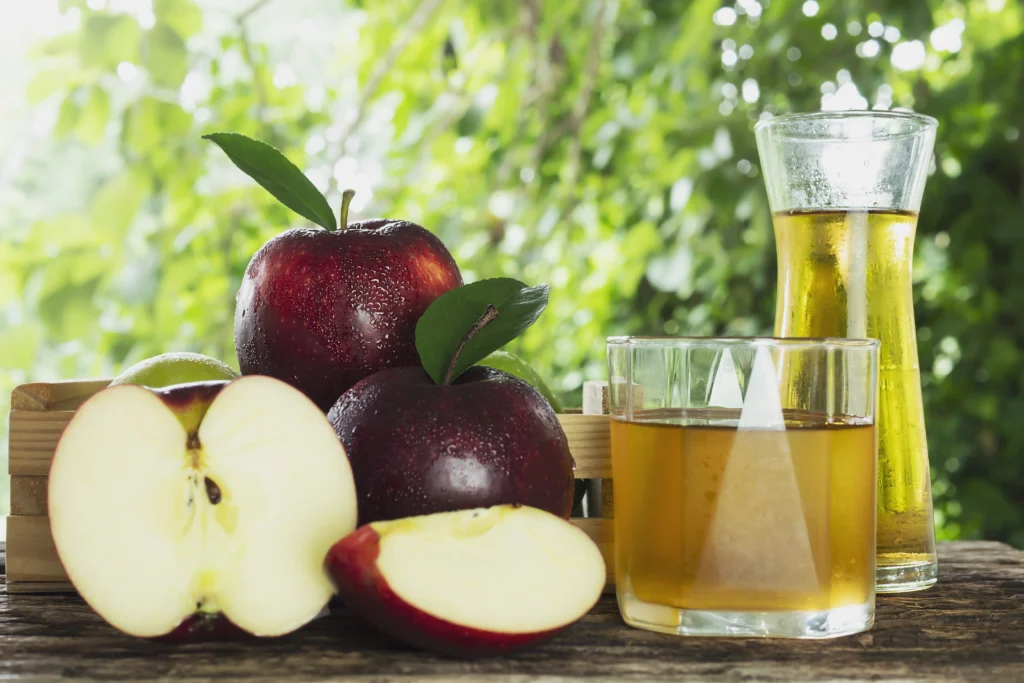Discover the Healthy Goodness of Apple Juice
Every morning, I used to grab coffee. Now, I start with a glass of apple juice. This simple change has made a big difference in my health.
Apple juice is more than a tasty drink. It’s full of nutrients that help you stay healthy. With 88% water, it keeps you hydrated and gives you important vitamins and minerals.
Apple juice is great for your heart and keeps you hydrated. It’s a favorite in many healthy homes. It’s perfect for a morning pick-me-up or a cool drink in the afternoon.
Table of Contents
Key Takeaways
- Apple juice is a top fruit juice in the United States
- Contains essential vitamins and minerals
- Provides excellent hydration with 88% water content
- Supports heart and overall health
- Can be part of a balanced diet
Understanding Apple Juice: Nature’s Sweet Beverage
Apple juice is a favorite drink that turns fresh apples into a tasty beverage. It goes through careful juice processing and packaging. Exploring apple juice, you’ll find many varieties with different tastes and health benefits.
Let’s explore the world of apple juice varieties and how they’re made:
Types of Apple Juice Available
- Fresh-pressed juice: Made directly from ripe apples, capturing maximum flavor
- 100% pure apple juice
- Apple cider variations
- Organic and conventional options
Clear vs. Cloudy Apple Juice
Clear and cloudy apple juice differ in how they’re processed. Clear juice is filtered a lot, removing pulp and sediment. Cloudy juice keeps more of the apple’s natural fiber and nutrients.
Processing Methods and Their Impact
Juice processing is key to the quality of the final product. Different methods change the juice’s taste, health value, and how long it lasts. Some important methods include:
- Pasteurization to ensure safety
- Filtration for clarity
- Concentration and reconstitution
- Cold pressing for maximum nutrient retention
It takes about 25 apples to make a gallon of apple juice. This shows how much work goes into making juice. When picking apple juice, think about the processing, where it comes from, and its health benefits. This helps you choose the best for your taste and health.
The Nutritional Profile of Apple Juice
Apple juice is a top pick for natural juices, full of important nutrients. A single cup has about 114 calories. It’s more than just a sweet drink.
Apple juice is a great source of vitamin C. This vitamin helps keep your immune system strong and your skin healthy. It also has:
- Flavonoids
- Phenolic acids
- Antioxidants
Potassium is another key nutrient in apple juice. It helps keep your blood pressure healthy and supports muscle function. Cloudy apple juice has more nutrients than clear juice, thanks to more apple solids.
But, it’s good to drink apple juice in small amounts. It has about 24 grams of sugar per serving. This can raise your blood sugar. Experts say to drink 4 to 8 ounces a day to get health benefits without too much sugar.
Pro tip: Choose freshly pressed or high-quality natural juices to ensure maximum nutritional value.
Whole apples and juice are different. Juice doesn’t have dietary fiber, which is good for your digestive system. Eating whole fruits is a great way to add fiber to your diet.
Health Benefits of Pure Apple Juice
Pure apple juice is a tasty drink full of health benefits. It’s more than just a sweet treat. It’s a source of nutrition and wellness for your daily life.
Antioxidant Properties and Protection
Apple juice is full of antioxidants that protect your body. These natural fighters help against oxidative stress. Cloudy apple juice has even more health benefits because of its high polyphenol levels.
- Reduces oxidative stress
- Fights free radicals
- Supports cellular health
Heart and Brain Health Support
Apple juice is good for your heart and brain. Studies show it may lower cholesterol and reduce heart disease risks. Quercetin and catechin in apple juice also help keep your mind sharp as you age.
Hydration and Electrolyte Balance
Apple juice is mostly water, making it great for staying hydrated. Its natural electrolytes keep your body working right. It’s perfect for after working out or every day.
Adding organic juices like apple juice to your diet is a tasty way to boost your health. It supports your nutritional needs in a delicious way.
When to Drink and When to Avoid Apple Juice

Understanding when to drink apple juice is key. It’s important to know when it’s healthy and when to skip it. Your health needs play a big role in this decision.
Some people should be careful with apple juice. Those with certain health issues need to watch their intake:
- People with diabetes due to high sugar content
- Individuals on low-sugar diets
- Those taking certain medications that might interact with juice
- People with compromised immune systems
The FDA offers important advice on juice intake. Some groups are at higher risk from fruit juices:
| Age Group | Recommended Daily Juice Intake | Precautions |
|---|---|---|
| Infants (0-12 months) | No juice recommended | Stick to breast milk or formula |
| Toddlers (1-3 years) | Up to 4 ounces | Avoid added sugars |
| Children (4-6 years) | Up to 6 ounces | Monitor for tooth decay |
| Children (7+ years) | Up to 8 ounces | Choose 100% fruit juices |
Pro tip: Always check for pasteurization and potential warning labels when purchasing fruit juices to ensure safety.
“Moderation is key when enjoying healthy beverages like apple juice” – Nutrition Experts
If you have health concerns or are on medication, talk to your doctor about juice. Healthy drinks like apple juice can be good for you if you drink them in the right amount.
Organic vs. Conventional Apple Juice
When picking apple juice, you have two main choices: organic and conventional. Knowing the differences helps you choose the best natural juice for you.
Organic juices are special because they’re made from apples grown without harmful chemicals. This means they might be healthier and cleaner. Organic products must meet strict rules to keep people and the planet safe.
Pesticide Considerations
Conventional apple juice is made differently than organic. Here are some key points about pesticides:
- Conventional apples get sprayed every 14 days when they’re growing
- Chlorpyrifos, a non-organic bug killer, has been used since the 1960s
- Organic farming uses good bugs and natural ways to fight pests
GMO Concerns and Certification
Organic juices are guaranteed to be non-GMO. The certification process makes sure that:
- Apples are grown in soil without synthetic stuff for at least three years
- No genetically modified organisms are used in making the juice
- There’s strict checking to stop any contamination
Environmental Impact
Choosing organic juices helps the environment. Organic farming uses fewer chemicals and keeps ecosystems healthy. The FDA checks both organic and conventional juices to make sure they’re safe.
Opting for organic juices supports green farming and might lower chemical exposure.
Recent FDA tests showed 88% of apple juice samples had no arsenic. The FDA’s limit is 10 parts per billion. This shows their dedication to providing safe, quality natural juices.
Creative Ways to Include Apple Juice in Your Diet

Apple juice is more than a drink. It’s a versatile ingredient that can make your recipes exciting. Let’s look at some fun ways to add it to your meals.
Think of apple juice as a secret ingredient in your cooking. It can make both sweet and savory dishes taste better with its natural sweetness and flavor.
- Smoothie Base: Use apple juice as a liquid foundation for nutrient-packed smoothies
- Baking Enhancement: Replace water with apple juice in cake and muffin recipes
- Frozen Treats: Create refreshing apple juice popsicles for summer cooling
- Marinades: Tenderize meats by incorporating apple juice into your marinade
Looking for something new to drink? Try these mixtures for a tasty twist:
| Beverage Combination | Recommended Ratio |
|---|---|
| Apple Juice + Ice Cream | 2:1 |
| Apple Juice + Soda | 1:1 |
| Apple Juice + Coffee | 6 oz : 2 oz |
Be adventurous with infusions. Add herbs like fresh mint or rosemary to your apple juice. These small changes can turn a simple drink into a fancy treat. Let rosemary steep in the fridge for hours or simmer for 10 minutes to get the most flavor.
Apple juice is more than a drink. It’s a kitchen ingredient waiting to be discovered.
Selecting and Storing Apple Juice
Choosing the right natural juices is important. You need to think about packaging, quality, and how to store them. How you pick and keep apple juice affects its taste, health benefits, and how much you enjoy it.
Reading Labels and Understanding Ingredients
When looking at juice packaging, pay attention to these points:
- Look for 100% pure apple juice labels
- Check for pasteurization details
- Verify absence of added sugars
- Examine preservative content
“The purest juice comes from careful ingredient selection and transparent labeling.”
Storage Tips for Maximum Freshness
Storing juice right is key to keeping it fresh. Here are some tips:
- Refrigerate unopened juice between 33-40°F
- Keep juice away from direct sunlight
- Seal containers tightly after opening
- Use clean utensils when serving
Shelf Life Guidelines
| Juice Type | Unopened Storage | Opened Refrigeration |
|---|---|---|
| Pasteurized Apple Juice | 12-18 months | 7-10 days |
| Fresh Pressed Juice | 3-5 days | 2-3 days |
Knowing these storage tips helps you enjoy apple juice at its best. You’ll get the best taste and health benefits.
Comparing Apple Juice with Other Fruit Juices
Apple juice is special among fruit juices because of its nutritional benefits. It has a good mix of nutrients. A small serving gives about 7% of the daily potassium and has 46 calories per 100g.
Apple juice has its own perks. Orange juice might have more vitamin C, but apple juice has more polyphenols. New juicing methods have made apple juice even more nutritious, with 400% more polyphenols. Pomegranate and beet juices are also good, but apple juice is easy to find.
Choosing the right juice depends on your health goals. Beetroot juice is great for heart health, and pomegranate juice is full of antioxidants. Apple juice helps with metabolism, which can lead to a smaller waist and lower metabolic syndrome risks. The NHS suggests drinking 150ml of juice a day for a healthy balance.
When picking a juice, think about what you need. Apple juice is a good choice because it’s not too high in calories and has lots of nutrients. Always check the labels and choose juices that are less processed to get the most health benefits.







